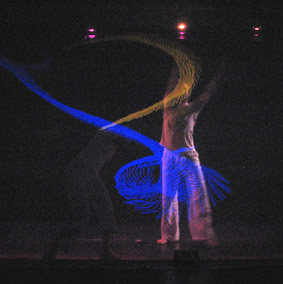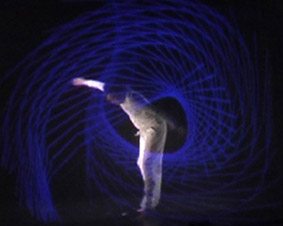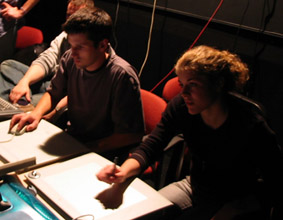Presence in Projecting Performance
Sita Popat
The nature of presence in dance is that it is inextricably connected with embodiment. Much of my work is linked to ideas surrounding presence and digital or new media technologies.
Drefus (2001) proposes that remote communications technologies are the place where Descartes might make his last stand, positing that ‘telehugs’ can never be the same as real hugs. I would heartily agree with him that no telepresent experience (currently) equates to the feeling of hugging a living, breathing, flesh-and-blood person, but that is not the only way that we experience presence.
The interactive and communication-based nature of many digital technologies lead us to explore new ways of being present (and absent), and thus we learn to recognise and accept new interfaces, concepts and experiences that expand our embodied selves on a daily basis.

Dancers Elizabeth Collier duets with a digital sprite
controlled by scenographer
My current project, with scenography colleague Scott Palmer and KMA Creative Technologies Ltd, considers the nature of the relationship between dancer, digital ‘sprite’ and technical operator in performance. In Projecting Performance, we are using digital images projected onto a screen across the stage as a medium for technical operators to inhabit the stage space as performers in their own right. The ‘sprites’ are partly computer-controlled and partly operator-controlled, and through them the operator has a presence on stage.
Danced duets between the on-stage dancer and the sprite are actually trios between dancer, computer and operator.

Dancer Paul Clark duets with a digital sprite
controlled by scenographer
Use of simple but fairly intuitive data-input systems such as graphics pen and tablet have enabled the operator to achieve an increasingly embodied experience, kinaesthetically connecting the motion of the hand to the motion of the sprite. Operators have described the experience of ‘dancing’ with the on-stage performer, despite being only remotely represented on stage by their sprite avatar, and have been observed using apparently redundant torso and arm movement when controlling the sprite.

Lisette Wright and technologist Tom Wexler
(KMA Creative Technologies)
The sense of presence is increased by the direct translation of the quality of the operator’s movement into the sprite’s response, and by the way in which that movement is mediated into the duet with the dancer. (The exact movement appears to be less important than the direction, force and quality of motion in achieving an embodied experience.) The responsiveness is multi-directional, with dancer, computer or operator leading or following at different times, creating an intricate triple partnership.
Interestingly, the technologists and scenographers made free and active use of the entire screen space, but when dancers were invited to control the sprites, their sense of physicality in the experience led them to keep the sprites in contact with the floor, limited by an imaginary gravity as the dancers know themselves to be limited by gravity. They were surprised when this limitation was pointed out to them, as they had not realised the extent to which they were projecting their own understandings of physical performance into the images that they were manipulating.
This research is in its early stages, having just received an AHRC large grant, and we hope to be able to expand upon our initial findings very soon.
Images reproduced by courtesy of Sita Popat
links to come
References




